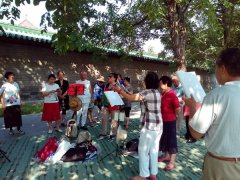Across China: Live the real life of Uygurs in a Xinjiang resort
URUMQI, Sept. 29 (Xinhua) -- Horses are uncommon in most Chinese cities, but in Kazanqi, horse-drawn carriages with distinctive decorative harnesses are a part of the traffic, sharing the roads with cars, bikes and pedestrians.
Kazanqi in Xinjiang Uygur Autonomous Region, is inhabited by Uygurs, Hui, Kazaks and Uzbeks. Uygurs account for 77 percent of the population.
In the Uygur language, Kazanqi means "people who earn a living by making cooking pots." Since opening for business in 2008, the tourist resort has been recognized among Chinese as a place to experience the traditional lifestyle of Xinjiang's ethnic minorities.
Ayizokran Yusuf, 21, has been working as a guide in Kazanqi since she graduated from a local college in 2015. In peak season, she handles about five tour groups each day but as the weather cools, there are just one or two groups.
"I love meeting different people every day, sharing my knowledge and learning about the lives of the tourists," Yusuf said.
Dressed in traditional Uygur clothing, Yusuf entertains her crowds as she explains to them the history and culture of her people. She tells them the stories behind the buildings, and explains to tourists that they should cross a gate with their right foot for luck, and jokes with the crowds, proclaiming one stall's homemade ice cream to be "the Haagen-Dazs of Xinjiang."
"We don't invite professional singers and dancers. We don't make any special decorations and we didn't relocate the residents here. It's just the way it has always been," said Haliman Awut, manager of the Kazanqi resort. What the tourists love most is authenticity, an escape from the artificial scenery of other resorts, she said.
"At first, residents had to be persuaded to open their homes to visitors. Now, they all want to be included in home visit listings," Awut said. Being included in the list means more money for the family.
Currently, there are 58 home-visit participants, which the management evaluates regularly.
"Before, a tour of Kazanqi would take a couple of hours, but now tourists stay at least one day to see everything," the manager said.
Tourists can not only visit courtyards and watch performances, but also learn how to make yogurt and nang, a kind of flatbread.
As more people come there, Kazanqi's central area is no longer able to accommodate them all. Yusuf is also feeling the change, noting that not only Chinese tourists enjoy Kazanqi, but there are also many groups from other countries.
"I hope more people will learn about Kazanqi and Uygur culture, but that the region will retain its charm," Yusuf said.















